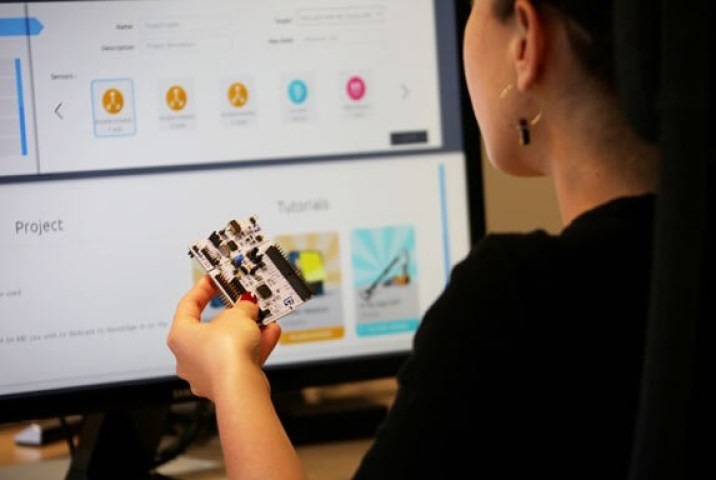Cartesiam Wins IoT World Startup AwardCartesiam Wins IoT World Startup Award
The French firm is aiming to bring artificial intelligence to humble microcontrollers.
August 27, 2020

Key takeaways from this article include the following:
The French startup Cartesiam focused on bringing artificial intelligence to microcontrollers has won the IoT World 2020 Startup Elevate Pitch-Off award.
The company has amassed a collection of 500 million algorithms.
First focusing on industrial applications, the company is diversifying into the home appliance and wearable markets.
Cartesiam, a small company focused on machine learning in edge devices, has won the IoT World 2020 Startup Elevate Pitch-Off award. Held at the 2020 IoT World conference, the competition required startups to pitch their products to a panel of industry leaders, investors and media.
Founded in 2016 in France, Cartesiam concluded that projections for the Internet of Things (IoT) market at that time were misguided. “Everyone was talking about IoT — deploying tens of billions if not hundreds of billions of devices,” recalled Marc Dupaquier, co-founder and managing director of the company. But despite the word “smart” to describe IoT-enabled devices and environments, many rely on the cloud to perform routine workflows. Yet using the cloud to process the bulk of IoT-based processing tasks will “not be economically viable,” Dupaquier concluded.
In Dupaquier’s view, IoT devices should have sufficient resources to understand operational parameters natively. A cloud outage shouldn’t prevent an IoT-enabled industrial machine, for instance, from sending an alert warning of a pending problem.
While such commonsense functionality has long been a promise of IoT technology, few companies have mature AI deployments. Fewer than one in 20 organizations have extensively integrated AI in offerings or processes, according to a survey from MIT Sloan Management Review.
The concept of performing artificial intelligence (AI) at the edge has grown in popularity recently. Adoption, however, remains at an early phase — especially when it comes to doing edge computing on resource-constrained hardware.
[For all our IoT World coverage, read our IoT World 2020 conference guide.]
In the middle of 2017, Cartesiam began developing a low-cost local computing platform that performs training and inference tasks at the edge. For hardware, the startup decided to focus on microcontroller units (MCUs), which range in cost from a few cents to a few dollars per board. The relatively limited horsepower of MCUs required bespoke machine learning and signal processing algorithms and logic; the bulk of recent AI research has relied on cloud architectures.
The company now has some 500 million algorithms for running AI operations on MCUs. While the company wrote algorithms manually at first, it was eventually able to generate scores of permutations of algorithms for narrow applications.
Cartesiam isn’t the only firm focused on edge computing architectures for IoT applications. AWS IoT Greengrass, for instance, aims to bring “local compute, messaging, data management, sync and ML Inference capabilities to edge devices,” as Amazon explained on its website.
In any event, predictive maintenance at the edge in industrial settings was an early focus area for Cartesiam. More recently, that focus has broadened to predictive maintenance for home appliances.
“Cartesiam appears to be taking a reasonable approach to distribute some of the AI and ML intelligence and algorithms to devices on the edge,” said Chris Kocher, managing director of Grey Heron. “This is really an optimization question as to how much to process centrally in the cloud at scale versus distributing processing out to edge devices to make intelligent decisions closer to the activity.”
The ability to make local decisions is important for many applications requiring immediate action, but that doesn’t mean edge architecture is warranted in every case, Kocher said. “A machine in a factory with access to unlimited power, connected to a nearby data center or cloud with high bandwidth may not need to have as much processing at the edge,” he said. “Each application will be a bit different.”
As for applications, Cartesiam is looking to expand its business to include wearables as well as industrial machines and home appliances. The analytics capabilities of many mainstream wearable devices are limited in Dupaquier’s estimation, who is a runner who has tested with multiple wearables. “The first time I played tennis, I wore an expensive wearable from a well-known global brand. Afterward, I received a text message from the wearable device that said something like: ‘Congratulations on a great swim,’” Dupaquier said. “My friends and colleagues told me I am probably not a very good tennis player if this algorithm confuses playing tennis with swimming.”
After that experience, Cartesiam began to work to change the functionality of off-the-shelf wearable devices by using neural networks. The approach is unconventional. Most companies rely on powerful central processing units (CPUs) or graphics processing units (GPUs) to train neural networks. “We hacked into other people’s devices, and put our software on them,” Dupaquier said.
The result is improved accuracy of activity tracking and expanded functionality, Dupaquier said. By analyzing users’ gait, AI-enabled wearables could predict when someone is about to fall. Analyzing such data makes more sense at the edge. “It’s not economically viable to send every footstep into the cloud,” Dupaquier said.
While the wearables market is relatively new for the company, Cartesiam has gained traction in the industrial sector, counting firms like Schneider Electric, Lacroix Electronics and the Singapore Agency for Science, Technology and Research as customers.
Having raised $2 million in funding, Cartesiam is seeking to raise an additional $5 million. While the current economic landscape remains challenging, Dupaquier is optimistic. “We are very much on track for 2020, and this in spite of COVID-19, and we expect to continue to be on track throughout the year,” he said.
About the Author
You May Also Like






